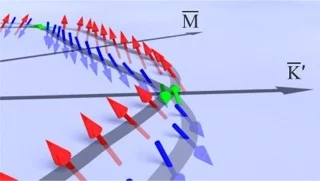In the emerging field of spintronics, the generation, injection, and in particular the control of highly spin polarized currents are main issues to be solved. Lifting of spin degeneracy by the spin-orbit interaction at surfaces, known as Rashba effect, represents a promising approach, since it generates two spin-polarized bands without the necessity of an external field. In our recent study, we realize such a system for a metallic surface layer on a semiconductor: Au/Ge(111). Based on a combination of spin-resolved photoemission with 3D detection and advanced density functional calculations, we have unveiled the complex spin texture at the Fermi surface. Due to the heavy atoms involved, this surface system shows a significant band splitting related to the spin-orbit interaction. Importantly, strong deviations from conventional Rashba physics occur. This pertains most prominently to a strong out-of-plane spin orientation. The spin pattern moreover shows in-plane rotations of the spin near mirror symmetry planes, which is observed for the first time. These findings pinpoint the complex spin texture found at surfaces, resulting from the potential landscape at the atomic scale. Interestingly, the spin texture bears close relationship to that predicted for the Fermi surface of topological insulators. Thus, these findings relate to a variety of topical solid-state issues, and could be stimulus for future studies of spin manipulation with regard to spintronics applications.
Read the full story
Read the full story
Facility: SLS
P. Höpfner, J. Schäfer, A. Fleszar, J. H. Dil, B. Slomski, F. Meier, C. Loho, C. Blumenstein, L. Patthey, W. Hanke, and R. Claessen
Phys. Rev. Lett. 108, 186801 (2012),DOI: 10.1103/PhysRevLett.108.186801
Swiss Light Source at Paul Scherrer Institut
Phone: +41 56 310 5388
Email: jan-hugo.dil@psi.ch
Reference
Three-Dimensional Spin Rotations at the Fermi Surface of a Strongly Spin-Orbit Coupled Surface SystemP. Höpfner, J. Schäfer, A. Fleszar, J. H. Dil, B. Slomski, F. Meier, C. Loho, C. Blumenstein, L. Patthey, W. Hanke, and R. Claessen
Phys. Rev. Lett. 108, 186801 (2012),DOI: 10.1103/PhysRevLett.108.186801
Contact
Dr. Jan Hugo DilSwiss Light Source at Paul Scherrer Institut
Phone: +41 56 310 5388
Email: jan-hugo.dil@psi.ch
